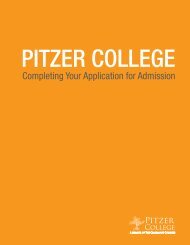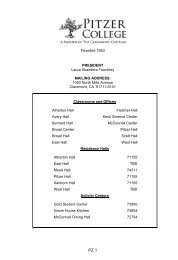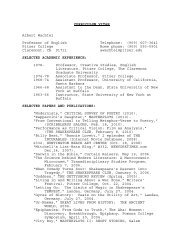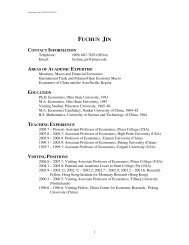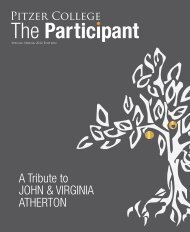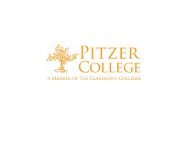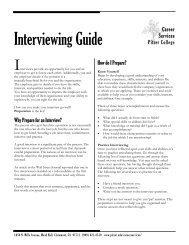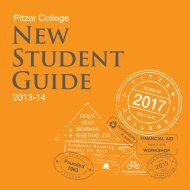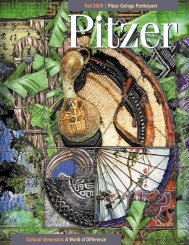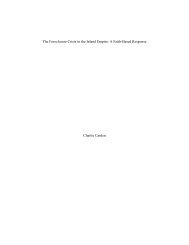You also want an ePaper? Increase the reach of your titles
YUMPU automatically turns print PDFs into web optimized ePapers that Google loves.
256 SCIENCE<br />
SCIENCE<br />
146L. Ecology. An exploration of the factors and interrelationships in influencing the<br />
distribution and abundance of organisms. Theoretical models and empirical data are<br />
applied to questions of biogeography, life histories, population regulation, community<br />
structure and resource management. Laboratory component will include an introduction<br />
to computer modeling in ecology, and the processing of quantitative data from field and<br />
laboratory investigations. Prerequisites: Biology 43, 44. Enrollment limited. Laboratory<br />
fee: $50. Fall, D. McFarlane.<br />
149. Neurobiology. This course will examine the structure, function and organization of<br />
nervous systems. Topics will include signal transduction, electrophysiology, the role of<br />
trophic factors, development of the nervous system, and neural networks. Consideration<br />
will also be given to neuropathologic conditions such as Parkinson’s’ and Alzheimer’s<br />
diseases. Prerequisites: Biology 43, 44; Chemistry 14, 15, or both semesters of the AISS<br />
course. Enrollment limited. Spring, M. Coleman.<br />
150La,b. Functional Human Anatomy and Biomechanics a: Limbs and Movement; b:<br />
Back and Core Stabilization.<br />
150La. Limbs and Movement. Development and evolutionary principles of limb design<br />
and function; mechanical properties of bone, soft tissues, muscle, nerve; interrelationships<br />
between structure, biomechanics, and function; open chain versus closed<br />
chain kinematics; mobility of limb girdles; mechanisms of injury and prevention.<br />
Laboratory involves dissection of human cadavers. Prerequisites: Biology 39L (or Dance<br />
160 or Dance 163); an introductory course in biology (Biology 43 or 44, or both semesters<br />
of the AISS course, or equivalent); a course in classical mechanics (Physics 30 or 33, or<br />
equivalent), and permission of instructor. Enrollment limited to 15. Laboratory fee: $100.<br />
Spring, J. Milton, Joint Science; E. Rega, Western University.<br />
150Lb. Back and Core Stabilization. Evolution and development of pronograde versus<br />
orthograde stance; development of pelvic diaphragm; mechanical properties of disks and<br />
vertebrate (creep); passive versus active stabilization and limb movement; back pain.<br />
Prerequisites: Biology 39L (or Dance 160 or Dance 163); an introductory course in biology<br />
(Biology 43 or 44, or both semesters of the AISS course, or equivalent); a course in<br />
classical mechanics (Physics 30 or 33, or equivalent), and permission of instructor.<br />
Enrollment limited to 15. Laboratory fee: $100. [not offered <strong>2007</strong>-<strong>08</strong>]<br />
151L. Developmental Biology. Lectures, discussions and laboratory exercises explore the<br />
current state of our understanding of how complex organisms arise from single cells.<br />
Topics will include growth, differentiation and pattern formation at the organismal,<br />
cellular and molecular levels, as well as the scientific basis of animal cloning and stem<br />
cell research. Prerequisites: Biology 43, 44; Chemistry 14, 15 (or 29), or both semesters of<br />
the AISS course, or permission of instructor. One previous upper-division Biology course<br />
is strongly recommended. Enrollment limited to 18. Laboratory fee: $50. Spring, R. Justice.<br />
154. Animal Behavior. Lectures, discussion and videos covering the biological approach<br />
to behavior. Topics include the physiological, neurological, genetic, evolutionary and<br />
ecological approaches to behavior, with an emphasis on behavioral ecology. Enrollment<br />
limited to 50. Prerequisites: Biology 43, 44, or both semesters of the AISS course, or<br />
permission of instructor. Fall, D. Thomson.<br />
157L. Cell Biology. This course examines the function of organisms at the cellular and<br />
molecular level through discussion, analysis of scientific literature, and laboratory<br />
experimentation. Topics include signal transduction, nuclear structure and function, cell<br />
division, and apoptosis (cell suicide). The laboratory uses modern cell biology techniques<br />
including fluorescent microscopy and immunodetection of proteins. Prerequisites:<br />
Biology 43, Chemistry 14 and 15 (or29), or both semesters of the AISS course, or permission<br />
of instructor. One previous upper-division Biology course is strongly recommended.<br />
Enrollment limited to 18. Laboratory fee $50. Fall/Spring, Z. Tang, J. Armstrong.<br />
158. Cell Cycle, Diseases and Aging. Introduces properties of cell-division cycle.<br />
Explores mechanisms of aging and diseases including cancer based on principles of cell<br />
cycle control. Elaborates on signaling pathways and molecular nature of the regulation<br />
fundamental to all eukaryotes. Emphasizes the advancements and current understanding<br />
of the field. Lectures, paper presentations, and discussions. Prerequisite: Biology 43, 44,<br />
or both semesters of the AISS course, and Chemistry 14, 15, or 29, or both semesters of<br />
the AISS course. Spring, Z. Tang.<br />
257<br />
159. Natural Resource Management. A course designed to allow students to appreciate<br />
the importance of the role of science in understanding environmental systems. Lectures<br />
will consist of an intensive analysis of natural resource problems and the impacts of<br />
human activities on these resources. Appropriate for biology or environmental studies<br />
concentrators with upper-division standing. Prerequisites: Biology 44. Enrollment limited.<br />
Spring, E. Morhardt.<br />
160. Immunology. A course dealing with topics of current research in immunology, such<br />
as antigen-antibody interactions, antibody synthesis, hypersensitivity, and autoimmunity.<br />
Students will prepare papers and participate in discussions based on the current<br />
literature. Outside speakers may supplement the material. Prerequisites: Biology 43, 44,<br />
or both semesters of the AISS course; Chemistry 14, 15 or both semesters of the AISS<br />
course; some advanced work in biology. Enrollment limited. [not offered <strong>2007</strong>-<strong>08</strong>]<br />
161. Cellular and Molecular Neurobiology. Current and historic methods of analysis will<br />
be discussed in relation to neurons and nervous system function. The focus will be on the<br />
cellular and molecular mechanisms underlying neuronal activity and function. The<br />
laboratory will introduce students to methods used for cellular neurobiology.<br />
Prerequisites: biology 43 and 44, or both semesters of the AISS course, and Chemistry 14<br />
and 15 (or 29), or both semesters of the AISS course. Enrollment limited to 18. Fall, M. Coleman.<br />
165. Advanced Topics in Environmental Biology. Readings and discussion of current<br />
technical journal articles in active areas of environmental biology. Topics are chosen for<br />
their current relevance and technical interest. Students present papers for class<br />
discussion, and conduct a formal literature review on the topic of their choice.<br />
Prerequisites: Biology 43, 44, or both semesters of the AISS course, or equivalent.<br />
Enrollment limited. Fall, E. Morhardt.<br />
166. Animal Physiological Ecology. This is an animal physiological ecology course that<br />
will emphasize physiological interactions of animals with their biotic and abiotic<br />
environments. Information about the physiology and ecology of animals will be<br />
integrated from the tissue, organ, and whole organism levels. We will cover a series of



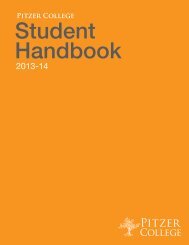

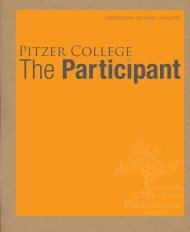
![Anticipated Courses SP14 [pdf] - Pomona College](https://img.yumpu.com/25363335/1/190x245/anticipated-courses-sp14-pdf-pomona-college.jpg?quality=85)
